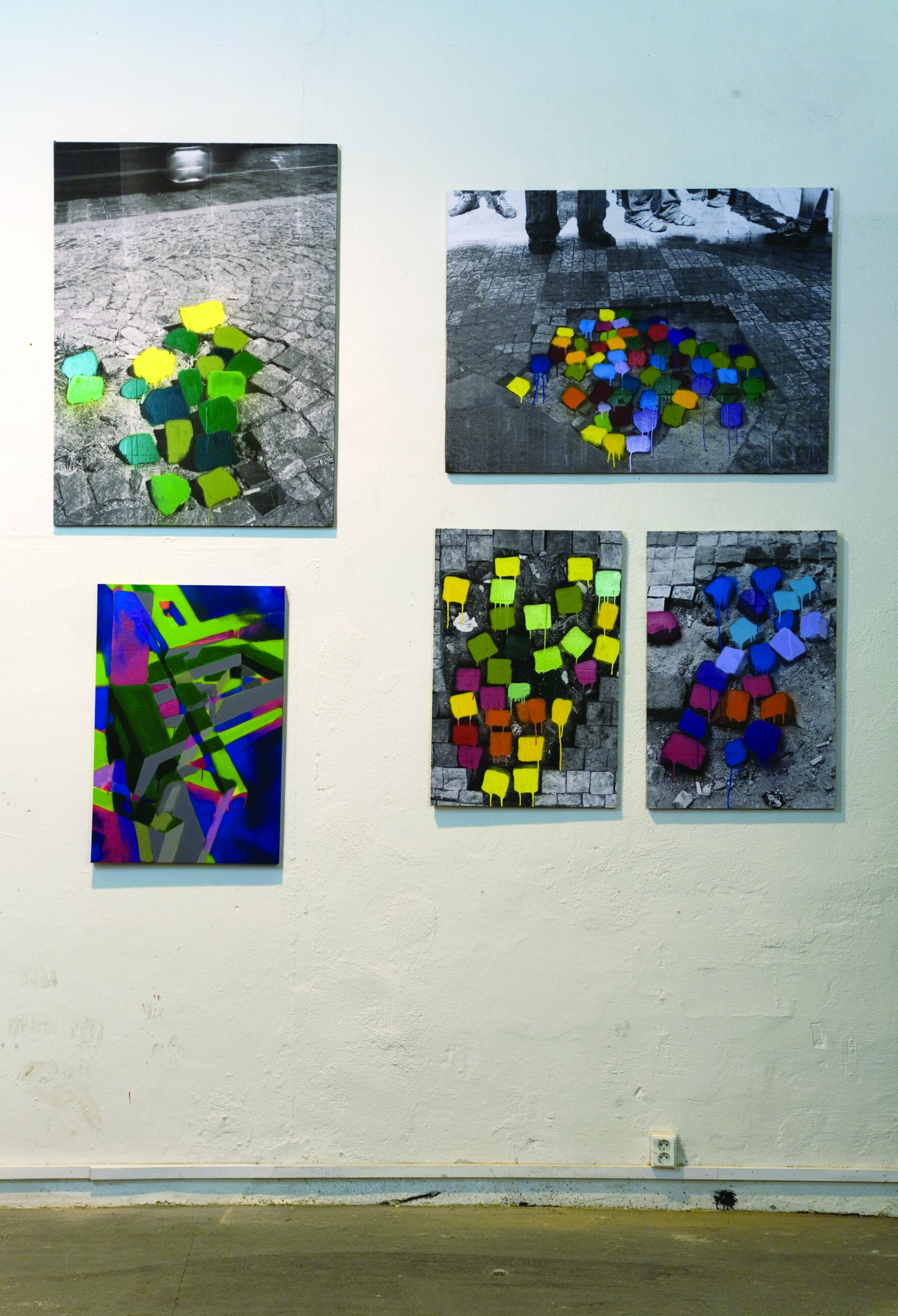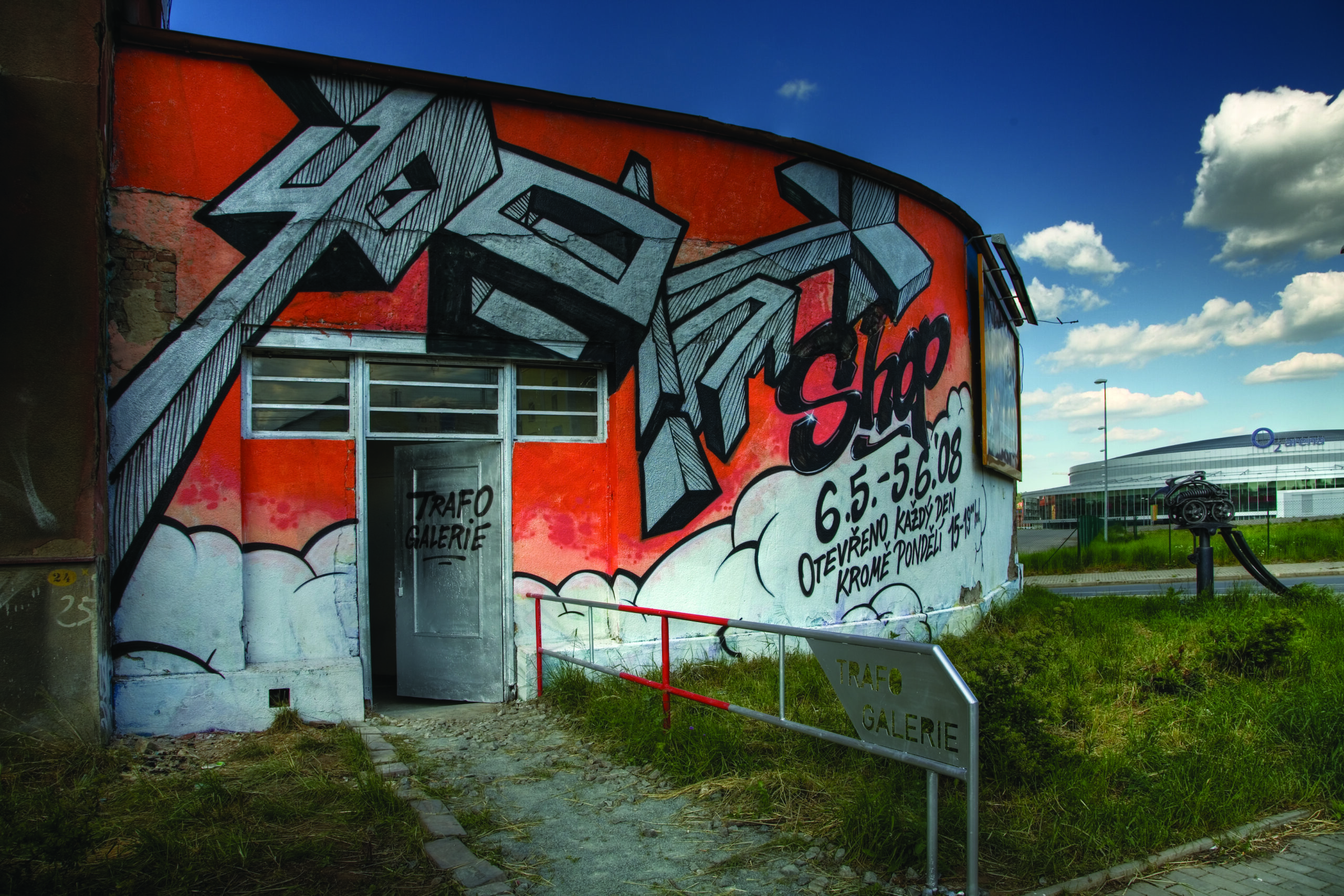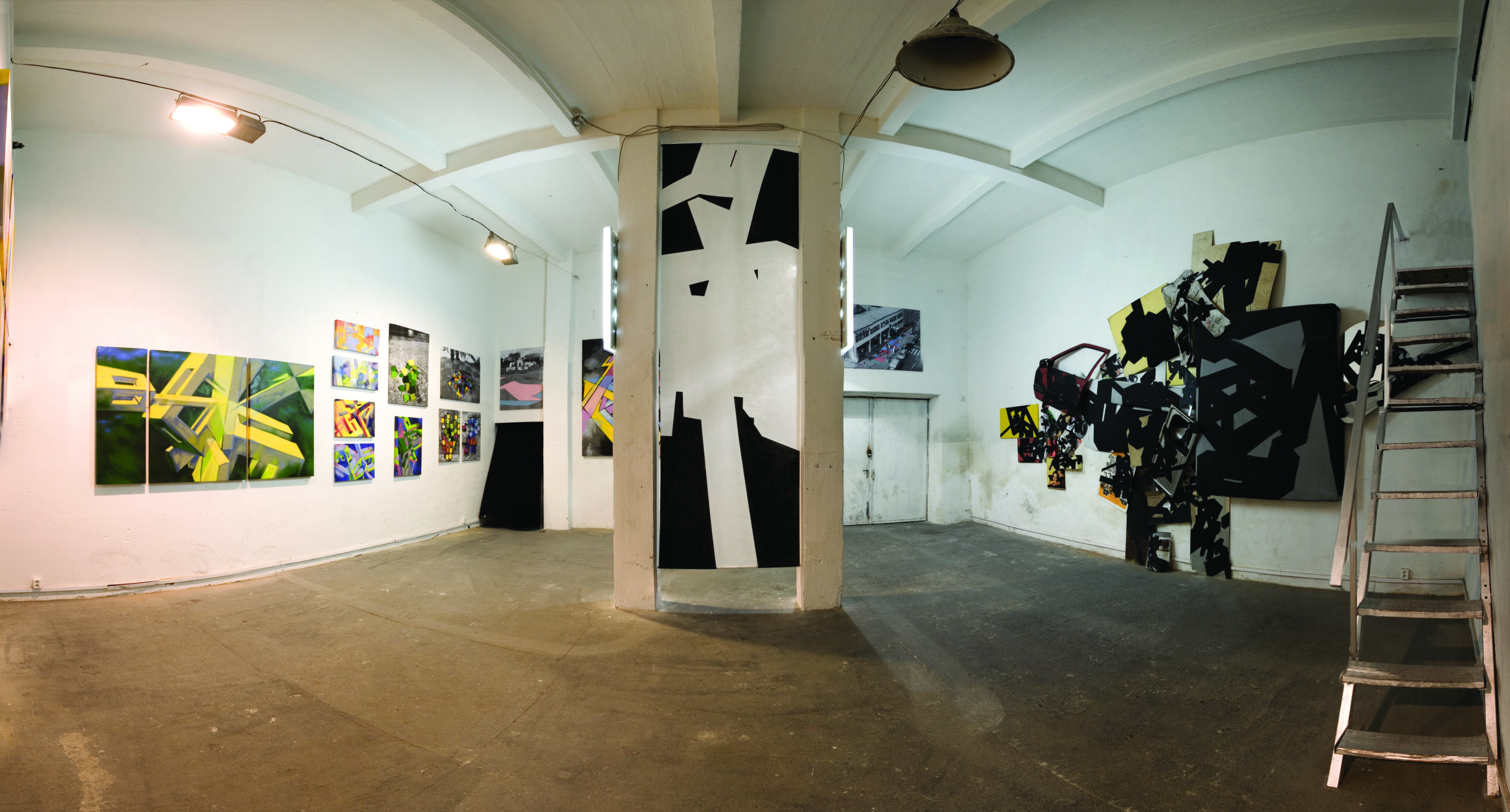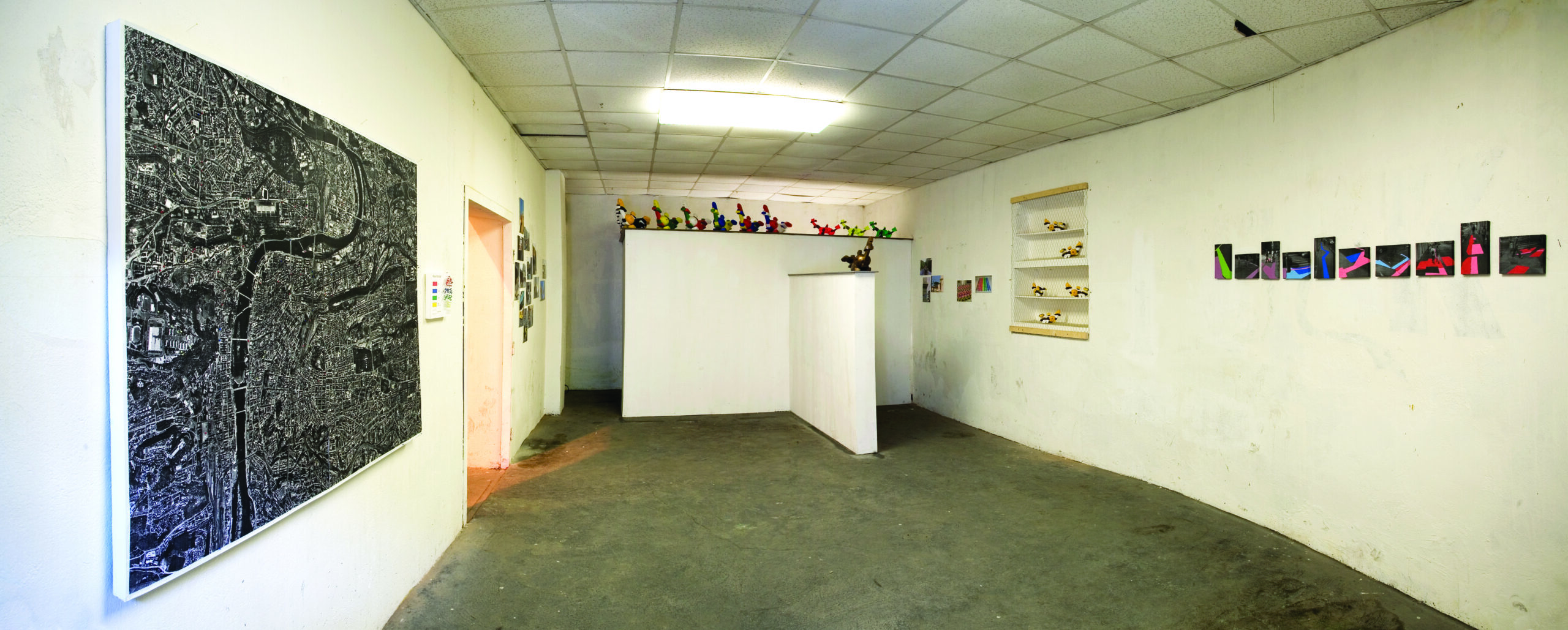Point Show by Petr Volf
This is what Jan Kaláb wrote in the upper left corner of his mural (Cakes, 2004) at the bend of Chotkova street in Prague, one of those highly visible places, especially when you go by the trams 18, 22 and 23:
“If I want something, I don’t ask permission“.
The blatancy of this self-confident, even arrogant statement impressed itself on my mind.However, there is a reason behind it, which is more profound than meets the eye. This is the way it works. Whoever wants to be someone in art must have self-confidence; without it he amounts to nothing, he may just as well take a job in a supermarket, or teach, for that matter. Unfortunately, self-confidence is even more important than talent, which is no longer required; sometimes it seems to me that it is rather to the artists’ disadvantage (they often try to hide it as if they were ashamed of it). That is why for the man or woman in the street contemporary art can be a strange, distant and hostile affair. Galleries are full of objects, pictures, videos and photographs that nobody actually absorbs for visual plea- sure. Nor do they help or make people think about the world. We have somehow forgotten the semantic link between art and skill.
Jan Kaláb has self-confidence. At the same time he has skill. His confidence in what he can do stems not only from the awareness of his artistic qualities, his undeniable talent, but is also based on results recognized both at home and abroad. He does not rely on isolated acts of creation followed by long pauses. He works hard for his works to be seen and to become the best. This means, in effect, that he lives for his art. He is growing in his self-confidence the only way he knows how.


Installation view
1 / 3
I am glad that there is someone like him.
A self-confident, even arrogant, but above all an original artist, who works simultaneously with several media with a powerful drive that
a lot of artists only talk about in cafés, but in fact know nothing about. In the past ten years Kaláb has produced hundreds of murals, three-dimensional reliefs, objects, installations as well as a number of graffiti painted trains. I wonder when he finds time to rest. Everywhere that he stayed he has left a visual trace, so to speak. I came across his graffiti in Rio de Janeiro. It was a strange feeling: an unexpected contact in a foreign city with something familiar, which immediately transported me to the faraway Prague.
I was lucky to see him defend his diploma work in June 2006 in the Veletržní Palace. I was curious to know how he was going to fare. So far everything had gone well for him. After a short stay at the Academy of Arts, Architecture and Design in Prague (VŠUP) he attended the Academy of Fine Arts (AVU). Here, at the most prestigious Czech art school, he continued to pursue that which he had been doing since the age of fifteen: graffiti and its variations. Kaláb managed to finish his studies at the Academy while fully concentrating on his favourite “street art disciplines” and not succumbing to the institutional pressures with which every student of AVU is confronted. He was the first graffiti artist to follow his own path through the Academy. He relentlessly modified a number of different letters (first Splesh, then Cakes and Point) to create an original visual language which harmoniously enriched the surroundings in which they appeared.
His professor, Jitka Svobodová, discovered his talent and let it grow; pro- fessors like her who do not impose their own ideas or turn students into their clones, are to be commended. In his diploma work entitled “Here is There” he summarized all his previous works, concentrating them – via the Internet – in one physical place, the Veletržní Palace. The commis- sion evaluating his work contained famous painters like Michael Rittstein and Jaroslav Róna. The latter admitted that Kaláb was the first graffiti artist he had met face to face; unbelievable in the 21st century…! I saw doubt in the eyes of the masters: the quality of the presented works was beyond question, but they were unable to understand that all of that stuff (classic graffiti murals, reliefs, little sculptures called “Pointies”, pavement art) was done in several weeks by one man.
He graduated with a straight A, unanimously, without any discussion. He left the Veletržní Palace, where the National Gallery stores its collection of modern art, as a Master of Arts.
The first exclusive exhibition of Jan Kaláb is taking place in the Trafo Gallery in Prague-Vysočany, shortly before the artist’s thirtieth birthday. He named it Pointshop. Someone may remember Keith Haring and his Pop Shop, which he opened in the 1980s in Manhattan to bring his art, based on the well-known figures, closer to people. It was a smart move commercially, of course: he succeeded in both worlds; his art outlived him without any harm to its popularity. Vysočany and Manhattan are relatively far apart, but Kaláb and Haring have more in common than meets the eye. When one thinks of it, their similarity becomes even closer.
Like Keith Haring who started to transform his sketched, spray painted or traditionally painted figures into sculptures, Jan Kaláb was the first in 2002 to come up with the concept of three-dimensional graffiti, which he has continued to develop since then. His “Point” – a large (and needless to say, illegal) installation on the concrete subway ventilation stack on Palachovo Square received positive media coverage and was welcomed by the public. City officials had it removed after two weeks. He had defined and further developed this space in a much better way than the unfortunate statue of the composer Dvořák in front of the Rudolfinum, oversized and inappropriately situated, which – despite promised “temporariness” – remains in the place.
Another expression of this direction are Kaláb’s “Pointies“, small sculptures made up of five letters of his nickname that, at first, look like Cubo-Futurist sculptures without any meaning apart from the expression of their shape dynamics. He installed tens of these in different colours on facades all over Prague using a ladder; later he spread them to Ber- lin and Gothenburg. In the Trafo Gallery they got an honorary position right at the beginning of the exhibition in a room featuring a satellite photograph of Prague into which visitors stuck pins indicating places where they stumbled upon any of the author’s works. There are lots of them. The whole city is dotted with his graffiti and art objects, it is hard to believe, and I still have to think of the rather baffled look on the face of Michael Rittstein and Jaroslav Róna. I myself am hard-pressed to believe. The quantity and quality are in such a rare harmony.
Kaláb’s greatest virtue – besides the exceptionally mature aesthetic feeling (I don’t think he could do anything repulsive, if he tried) – is the ability to transcend the boundaries of a certain medium, and the cour- age to experiment. I can only mention his feat of colouring puddles with pigments and his painted interpretations of pavement stains and cracks, which he transformed into large abstract public space paintings. He made Xerox copies of the photographs he took of them, which he, eventually, repainted to create original artefacts. This tells us a lot about his progression towards pictures, oil paintings and acrylic paintings on canvas. They were a high point of the exhibition in the Trafo Gallery. The critic Jiří Machalický wrote (Lidové noviny, May 17, 2008): “They have a well thought-out composition, indebted to the interwar Constructivism, or the abstractions of Mondrian and van Doesburg. Manifest in his paintings is a greater freedom and dynamism together with a fine sense of colour relations.” To be cited in the company of these two masters of modern art is a praise and clear appreciation of quality. But the critic only described what is self-evident when looking at Kaláb’s works (not only paintings): a perfectly thought-out composition, a talent for coping with a “canvas” of any size.
It is quite possible that if he concentrated on painting alone, he would come up with results that would at least invigorate the contemporary painting scene. But this would mean leaving the streets and locking oneself away in a studio, and I cannot imagine anything like that happening. He would miss the sun, the smog, the streets and facades; the city of which he became a part.
Where all of this will lead is difficult to say. Jan Kaláb is an unpredictable artist. On the Těšnov wall, the touchstone for every ambitious graffiti artist, he described himself using these words: “Cakes is a loafer, Cakes is a king, he finds his own way.” We’ll see. They say real maturity comes after thirty.

Installation view

The first bronze Pointik




 Back to overview
Back to overview